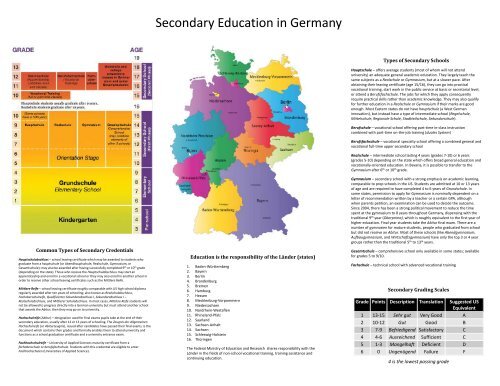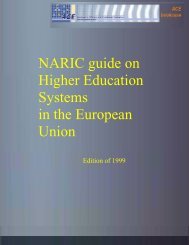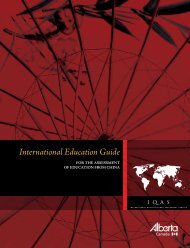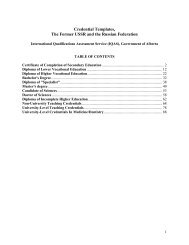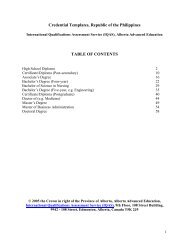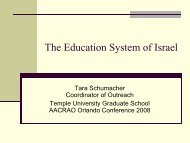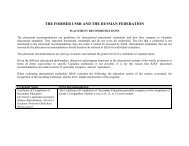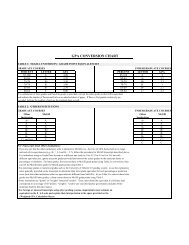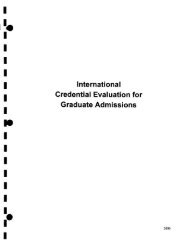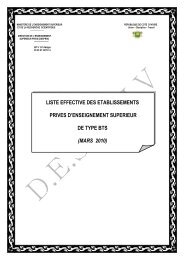Secondary Education in Germany
Secondary Education in Germany
Secondary Education in Germany
Create successful ePaper yourself
Turn your PDF publications into a flip-book with our unique Google optimized e-Paper software.
<strong>Secondary</strong> <strong>Education</strong> <strong>in</strong> <strong>Germany</strong><br />
Common Types of <strong>Secondary</strong> Credentials<br />
Hauptschulabschluss – school leav<strong>in</strong>g certificate which may be awarded to students who<br />
graduate from a hauptschule (or Abendhauptschule, Realschule, Gymnasium, or<br />
Gesamtschule); may also be awarded after hav<strong>in</strong>g successfully completed 9 th or 10 th grade<br />
(depend<strong>in</strong>g on the state). Those who receive the Hauptschulabschluss may start an<br />
apprenticeship and enroll <strong>in</strong> a vocational school or they may also enroll <strong>in</strong> another school <strong>in</strong><br />
order to receive other school leav<strong>in</strong>g certificates such as the Mittlere Reife.<br />
Mittlere Reife – school leav<strong>in</strong>g certificate roughly comparable with US high school diploma<br />
regularly awarded after ten years of school<strong>in</strong>g; also known as Realschulabschluss,<br />
Fachoberschulreife, Qualifizierter Sekundarabschluss I, Sekundarabschluss I –<br />
Realschulabschluss, and Mittlerer Schulabschluss. In most cases, Mittlere Reife students will<br />
not be allowed to progress directly <strong>in</strong>to a German university but must attend another school<br />
that awards the Abitur; then they may go on to university.<br />
Hochschulreife (Abitur) –designation used for f<strong>in</strong>al exams pupils take at the end of their<br />
secondary education, usually after 12 or 13 years of school<strong>in</strong>g. The Zeugnis der Allgeme<strong>in</strong>en<br />
Hochschulreife (or Abiturzeugnis), issued after candidates have passed their f<strong>in</strong>al exams, is the<br />
document which conta<strong>in</strong>s their grades and formally enables them to attend university and<br />
functions as a school graduation certificate and a university entrance exam.<br />
Fachhochschulreife –University of Applied Sciences maturity certificate from a<br />
fachoberschule or berufsfachschule. Students with this credential are eligible to enter<br />
Fachhochschulen (Universities of Applied Science).<br />
<strong>Education</strong> is the responsibility of the Länder (states)<br />
1. Baden‐Württemberg<br />
2. Bayern<br />
3. Berl<strong>in</strong><br />
4. Brandenburg<br />
5. Bremen<br />
6. Hamburg<br />
7. Hessen<br />
8. Mecklenburg‐Vorpommern<br />
9. Niedersachsen<br />
10. Nordrhe<strong>in</strong>‐Westaflen<br />
11. Rh<strong>in</strong>eland‐Pfalz<br />
12. Saarland<br />
13. Sachsen‐Anhalt<br />
14. Sachsen<br />
15. Schleswig‐Holste<strong>in</strong><br />
16. Thür<strong>in</strong>gen<br />
The Federal M<strong>in</strong>istry of <strong>Education</strong> and Research shares responsibility with the<br />
Länder <strong>in</strong> the fields of non‐school vocational tra<strong>in</strong><strong>in</strong>g, tra<strong>in</strong><strong>in</strong>g assistance and<br />
cont<strong>in</strong>u<strong>in</strong>g education.<br />
Types of <strong>Secondary</strong> Schools<br />
Hauptschule –offers average students (most of whom will not attend<br />
university) an adequate general academic education. They largely teach the<br />
same subjects as a Realschule or Gymnasium, but at a slower pace. After<br />
obta<strong>in</strong><strong>in</strong>g their leav<strong>in</strong>g certificate (age 15/16), they can go <strong>in</strong>to practical<br />
vocational tra<strong>in</strong><strong>in</strong>g, start work <strong>in</strong> the public service at basic or secretarial level,<br />
or attend a Berufsfachschule. The jobs for which they apply consequently<br />
require practical skills rather than academic knowledge. They may also qualify<br />
for further education <strong>in</strong> a Realschule or Gymnasium if their marks are good<br />
enough. Most Eastern states do not have hauptschule (a West German<br />
<strong>in</strong>novation), but <strong>in</strong>stead have a type of <strong>in</strong>termediate school (Regelschule,<br />
Mittelschule, Regionale Schule, Stadtteilschule, Sekundarschule).<br />
Berufschule –vocational school offer<strong>in</strong>g part‐time <strong>in</strong>‐class <strong>in</strong>struction<br />
comb<strong>in</strong>ed with part‐time on‐the‐job tra<strong>in</strong><strong>in</strong>g (duales System)<br />
Berufsfachschule –vocational specialty school offer<strong>in</strong>g a comb<strong>in</strong>ed general and<br />
vocational full‐time upper secondary school<br />
Realschule –<strong>in</strong>termediate school last<strong>in</strong>g 4 years (grades 7‐10) or 6 years<br />
(grades 5‐10) depend<strong>in</strong>g on the state which offers broad general education and<br />
vocationally‐oriented education. In Bavaria, it is possible to transfer to the<br />
Gymnasium after 6 th or 10 th grade.<br />
Gymnasium – secondary school with a strong emphasis on academic learn<strong>in</strong>g,<br />
comparable to prep schools <strong>in</strong> the US. Students are admitted at 10 or 13 years<br />
of age and are required to have completed 4 to 6 years of Grundschule. In<br />
some states, permission to apply for Gymnasium is nom<strong>in</strong>ally dependent on a<br />
letter of recommendation written by a teacher or a certa<strong>in</strong> GPA, although<br />
when parents petition, an exam<strong>in</strong>ation can be used to decide the outcome.<br />
S<strong>in</strong>ce 2004, there has been a strong political movement to reduce the time<br />
spent at the gymnasium to 8 years throughout <strong>Germany</strong>, dispens<strong>in</strong>g with the<br />
traditional 9 th year (Oberprima), which is roughly equivalent to the first year of<br />
higher education. F<strong>in</strong>al year students take the Abitur f<strong>in</strong>al exam. There are a<br />
number of gymnasien for mature students, people who graduated from school<br />
but did not receive an Abitur. Most of these schools (like Abendgymnasium,<br />
Aufbaugymnasium, and Wirtschaftsgymnasium) have only the top 3 or 4 year<br />
groups rather than the traditional 5 th to 13 th years.<br />
Gesamtschule – comprehensive school only available <strong>in</strong> some states; available<br />
for grades 5 to 9/10.<br />
Fachschule – technical school with advanced vocational tra<strong>in</strong><strong>in</strong>g<br />
<strong>Secondary</strong> Grad<strong>in</strong>g Scales<br />
Grade Po<strong>in</strong>ts Description Translation Suggested US<br />
Equivalent<br />
1 13‐15 Sehr gut Very Good A<br />
2 10‐12 Gut Good B<br />
3 7‐9 Befriedigend Satisfactory C<br />
4 4‐6 Ausreichend Sufficient C<br />
5 1‐3 Mangelhaft Deficient D<br />
6 0 Ungenügend Failure F<br />
4 is the lowest pass<strong>in</strong>g grade
13<br />
12<br />
11<br />
10<br />
10<br />
9<br />
8<br />
7<br />
6<br />
5<br />
4<br />
3<br />
2<br />
1<br />
grade<br />
Basic Structure of the <strong>Education</strong>al System <strong>in</strong> the Federal Republic of <strong>Germany</strong><br />
Pre-school Educ. Primary <strong>Education</strong> <strong>Secondary</strong> level I <strong>Secondary</strong> level II Tertiary <strong>Education</strong> Further Ed.<br />
Qualification of vocational<br />
further education<br />
FACHSCHULE 12)<br />
CONTINUING EDUCATION<br />
(various forms of cont<strong>in</strong>u<strong>in</strong>g general, vocational and academic education)<br />
Allgeme<strong>in</strong>e<br />
Hochschulreife<br />
Diplom, Bachelor<br />
BERUFSAKADEMIE 15)<br />
GRUNDSCHULE 1)<br />
KINDERGARTEN<br />
(optional)<br />
Doctorate (Promotion)<br />
Degree or exam<strong>in</strong>ation after a first course of study<br />
(Diplom, Magister, Staatsprüfung;<br />
Bachelor, Master)<br />
UNIVERSITÄT 13)<br />
TECHNISCHE UNIVERSITÄT/<br />
TECHNISCHE HOCHSCHULE<br />
PÄDAGOGISCHE HOCHSCHULE 14)<br />
KUNSTHOCHSCHULE<br />
MUSIKHOCHSCHULE<br />
FACHHOCHSCHULE<br />
VERWALTUNGSFACHHOCHSCHULE<br />
Fachgebundene<br />
Hochschulreife Allgeme<strong>in</strong>e Hochschulreife<br />
19<br />
BERUFS-<br />
Berufsqualifizierender Abschluss 11) Fachhochschulreife OBER-<br />
18<br />
2) 7)<br />
SCHULE 8) GYMNASIALE OBERSTUFE<br />
BERUFSSCHULE and BERUFS- FACH-<br />
ON-THE-JOB-TRAINING<br />
<strong>in</strong> the different school types: 17<br />
FACH- OBER-<br />
(Dual System of vocational<br />
SCHULE 10)<br />
Gymnasium,<br />
education) 2)<br />
SCHULE 9)<br />
Berufliches Gymnasium/<br />
16<br />
Fachgymnasium, Gesamtschule<br />
15<br />
Mittlerer Schulabschluss (Realschule leav<strong>in</strong>g certificate) after 10 years,<br />
First general education qualification (Hauptschule leav<strong>in</strong>g certificate) after 9 years 6)<br />
16<br />
10th grade<br />
15<br />
HAUPTSCHULE 4) 14<br />
REALSCHULE 4) GESAMT- GYMNASIUM 5)<br />
SCHULE 5)<br />
13<br />
12<br />
Orientation phase 3)<br />
11<br />
SONDERKINDER- SONDERSCHULE 2) SONDERSCHULE 2)<br />
GARTEN<br />
ABENDGYMNASIUM/<br />
KOLLEG<br />
10<br />
9<br />
8<br />
7<br />
6<br />
5<br />
4<br />
3<br />
age<br />
Published by: Secretariat of the Stand<strong>in</strong>g Conference of the M<strong>in</strong>isters of <strong>Education</strong> and Cultural Affairs of the Länder <strong>in</strong> the<br />
Federal Republic of <strong>Germany</strong>, Documentation and <strong>Education</strong> Information Service, Graurhe<strong>in</strong>dorfer Str. 157, 53117 Bonn,<br />
<strong>Germany</strong>, Tel.+49 (0)228 501-0. © KMK 2012
Annotations<br />
Diagram of the basic structure of the education system. The distribution of the school population <strong>in</strong> grade 8<br />
as per 2010 taken as a national average is as follows: Hauptschule 16.6 per cent, Realschule 25.0 per cent,<br />
Gymnasium 36.3 per cent, <strong>in</strong>tegrierte Gesamtschule 9.2 per cent, types of school with several courses of<br />
education 7.8 per cent, special schools 4.2 per cent.<br />
The ability of pupils to transfer between school types and the recognition of school-leav<strong>in</strong>g qualifications is<br />
basically guaranteed if the preconditions agreed between the Länder are fulfilled. The duration of full-time<br />
compulsory education (compulsory general education) is n<strong>in</strong>e years (10 years <strong>in</strong> five of the Länder) and the<br />
subsequent period of part-time compulsory education (compulsory vocational education) is three years.<br />
1 In some Länder special types of transition from pre-school to primary education (Vorklassen,<br />
Schulk<strong>in</strong>dergärten) exist. In Berl<strong>in</strong> and Brandenburg the primary school comprises six grades.<br />
2 The disabled attend special forms of general-education and vocational school types (partially <strong>in</strong>tegrated<br />
with non-handicapped pupils) depend<strong>in</strong>g on the type of disability <strong>in</strong> question. Designation of schools<br />
varies accord<strong>in</strong>g to the law of each Land (Förderschule / Schule für Beh<strong>in</strong>derte / Sonderschule /<br />
Förderzentrum). The Förderschule with a focus on “learn<strong>in</strong>g” (school for children with learn<strong>in</strong>g<br />
difficulties, Schule für Lernbeh<strong>in</strong>derte) and the Förderschule with a focus on “mental development”<br />
award school-specific qualifications.<br />
3 Grades 5 and 6 constitute a phase of particular promotion, supervision and orientation with regard to the<br />
pupil's future educational path and its particular direction.<br />
4 The Hauptschule and Realschule courses of education are also offered at schools with several courses<br />
of education, for which the names differ from one Land to another. The follow<strong>in</strong>g types of school br<strong>in</strong>g<br />
the courses of education of Hauptschule and Realschule under one educational and organisational<br />
umbrella: Mittelschule (Sachsen), Regelschule (Thür<strong>in</strong>gen), Sekundarschule (Bremen, Sachsen-Anhalt),<br />
Erweiterte Realschule (Saarland), Verbundene Haupt- und Realschule (Hessen), Haupt- und Realschule<br />
(Hamburg), Regionale Schule (Mecklenburg-Vorpommern), Realschule plus (Rhe<strong>in</strong>land-Pfalz),<br />
Regionalschule (Schleswig-Holste<strong>in</strong>), Oberschule (Brandenburg), Mittelstufenschule (Hessen).<br />
5 The Gymnasium course of education is also offered at comprehensive schools (Gesamtschule). In the<br />
cooperative comprehensive schools, the three courses of education (Hauptschule, Realschule and<br />
Gymnasium) are brought under one educational and organisational umbrella; these form an educational<br />
and organisational whole at the <strong>in</strong>tegrated Gesamtschule. The provision of comprehensive schools<br />
(Gesamtschulen) varies <strong>in</strong> accordance with the respective educational laws of the Länder. Three<br />
courses of education are also offered at the follow<strong>in</strong>g types of school: Integrierte Sekundarschule<br />
(Berl<strong>in</strong>), Oberschule (Bremen, Niedersachsen), Stadtteilschule (Hamburg), to some extent Regionale<br />
Schule (Mecklenburg-Vorpommern), Geme<strong>in</strong>schaftsschule (Schleswig-Holste<strong>in</strong>, Thür<strong>in</strong>gen).<br />
6 The general education qualifications that may be obta<strong>in</strong>ed after grades 9 and 10 carry particular<br />
designations <strong>in</strong> some Länder. These certificates can also be obta<strong>in</strong>ed <strong>in</strong> even<strong>in</strong>g classes and at<br />
vocational schools or through an external exam<strong>in</strong>ation before a state exam<strong>in</strong><strong>in</strong>g board.<br />
7 Admission to the Gymnasiale Oberstufe requires a formal entrance qualification which can be obta<strong>in</strong>ed<br />
after grade 9 or 10. At present, <strong>in</strong> the majority of Länder the Allgeme<strong>in</strong>e Hochschulreife can be obta<strong>in</strong>ed<br />
after the successful completion of 13 consecutive school years (n<strong>in</strong>e years at the Gymnasium). Yet <strong>in</strong><br />
almost all Länder the gradual conversion to eight years at the Gymnasium is currently under way, where<br />
the Allgeme<strong>in</strong>e Hochschulreife can be obta<strong>in</strong>ed after a 12-year course of education.<br />
8 The Berufsoberschule has so far only existed <strong>in</strong> a few Länder and offers school-leavers with the<br />
Mittlerer Schulabschluss who have completed vocational tra<strong>in</strong><strong>in</strong>g or five years’ work<strong>in</strong>g experience the<br />
opportunity to obta<strong>in</strong> the Fachgebundene Hochschulreife. Pupils can obta<strong>in</strong> the Allgeme<strong>in</strong>e<br />
Hochschulreife by prov<strong>in</strong>g their proficiency <strong>in</strong> a second foreign language.
9 The Fachoberschule is a school type last<strong>in</strong>g for two years (grades 11 and 12) which admits pupils who<br />
have completed the Mittlerer Schulabschluss and qualifies them to study at a Fachhochschule. Pupils<br />
who have successfully completed the Mittlerer Schulabschluss and have been through <strong>in</strong>itial vocational<br />
tra<strong>in</strong><strong>in</strong>g can also enter the Fachoberschule directly <strong>in</strong> grade 12. The Länder may also establish a<br />
grade 13. After successful completion of grade 13, pupils can obta<strong>in</strong> the Fachgebundene Hochschulreife<br />
and under certa<strong>in</strong> conditions the Allgeme<strong>in</strong>e Hochschulreife.<br />
10 Berufsfachschulen are full-time vocational schools differ<strong>in</strong>g <strong>in</strong> terms of entrance requirements, duration<br />
and leav<strong>in</strong>g certificates. Basic vocational tra<strong>in</strong><strong>in</strong>g can be obta<strong>in</strong>ed dur<strong>in</strong>g one- or two-year courses at<br />
Berufsfachschulen and a vocational qualification is available at the end of two- or three-year courses.<br />
Under certa<strong>in</strong> conditions the Fachhochschulreife can be acquired on completion of a course last<strong>in</strong>g a<br />
m<strong>in</strong>imum of two years.<br />
11 Extension courses are offered to enable pupils to acquire qualifications equivalent to the Hauptschule<br />
and Realschule leav<strong>in</strong>g certificates.<br />
12 Fachschulen cater for vocational cont<strong>in</strong>u<strong>in</strong>g education (1–3 year duration) and as a rule require the<br />
completion of relevant vocational tra<strong>in</strong><strong>in</strong>g <strong>in</strong> a recognised occupation and subsequent employment. In<br />
addition, the Fachhochschulreife can be acquired under certa<strong>in</strong> conditions.<br />
13 Includ<strong>in</strong>g <strong>in</strong>stitutions of higher education offer<strong>in</strong>g courses <strong>in</strong> particular discipl<strong>in</strong>es at university level (e.g.<br />
theology, philosophy, medic<strong>in</strong>e, adm<strong>in</strong>istrative sciences, sport).<br />
14 Pädagogische Hochschulen (only <strong>in</strong> Baden-Württemberg) offer tra<strong>in</strong><strong>in</strong>g courses for teachers at various<br />
types of schools. In specific cases, study courses lead<strong>in</strong>g to professions <strong>in</strong> the area of education and<br />
pedagogy outside the school sector are offered as well.<br />
15 The Berufsakademie is a tertiary sector <strong>in</strong>stitution <strong>in</strong> some Länder offer<strong>in</strong>g academic tra<strong>in</strong><strong>in</strong>g at a<br />
Studienakademie (study <strong>in</strong>stitution) comb<strong>in</strong>ed with practical <strong>in</strong>-company professional tra<strong>in</strong><strong>in</strong>g <strong>in</strong> keep<strong>in</strong>g<br />
with the pr<strong>in</strong>ciple of the dual system.<br />
As at January 2012<br />
GLOSSARY<br />
Abendgymnasium<br />
Establishment of the so-called Zweiter Bildungsweg at which adults can attend even<strong>in</strong>g classes to<br />
obta<strong>in</strong> the general higher education entrance qualification.<br />
Allgeme<strong>in</strong>e Hochschulreife<br />
General higher education entrance qualification. Entitles holder to admission to all subjects at all higher<br />
education <strong>in</strong>stitutions and is usually obta<strong>in</strong>ed at upper →Gymnasium level (→gymnasiale Oberstufe) by<br />
pass<strong>in</strong>g the Abitur exam<strong>in</strong>ation.<br />
Bachelor<br />
The Bachelor’s degree as a first higher education degree provides qualification for a profession. It can<br />
be obta<strong>in</strong>ed after a standard period of study (Regelstudienzeit) of six, seven or eight semesters at<br />
universities and equivalent <strong>in</strong>stitutions of higher education, at colleges of art and music and at<br />
→Fachhochschulen. Together with the →Master's degree, the Bachelor's degree is part of a graduation<br />
system of consecutive degrees which is to replace the traditional system of higher education<br />
qualifications (→Diplom and →Magister). Bachelor’s qualifications provide the same rights as Diplom<br />
qualifications of Fachhochschulen. The Bachelor’s degree may also be obta<strong>in</strong>ed as a tertiary education<br />
qualification provid<strong>in</strong>g qualification for a profession at Berufsakademien.<br />
Berufliches Gymnasium<br />
Type of school at upper secondary level offer<strong>in</strong>g a three-year course of education which <strong>in</strong>cludes both<br />
the general education subjects taught at upper →Gymnasium level (→gymnasiale Oberstufe) and
career-oriented subjects, such as bus<strong>in</strong>ess and technology, but which also leads to the general higher<br />
education entrance qualification.<br />
Berufsschule<br />
Vocational school at upper secondary level generally provid<strong>in</strong>g part-time <strong>in</strong>struction <strong>in</strong> general and<br />
vocational subjects to tra<strong>in</strong>ees receiv<strong>in</strong>g vocational education and tra<strong>in</strong><strong>in</strong>g with<strong>in</strong> the dual system.<br />
Diplom<br />
The Diplom degree as a higher education qualification provides qualification for a profession. It may be<br />
obta<strong>in</strong>ed either at universities and equivalent <strong>in</strong>stitutions of higher education, at colleges of art and<br />
music (particularly <strong>in</strong> social or economic sciences and <strong>in</strong> natural and eng<strong>in</strong>eer<strong>in</strong>g sciences), or likewise<br />
at →Fachhochschulen (<strong>in</strong> all subjects, with the specification Fachhochschule or FH added to the<br />
degree title). The Diplom degree may also be obta<strong>in</strong>ed as a tertiary education qualification provid<strong>in</strong>g<br />
qualification for a profession at Berufsakademien (with the specification Berufsakademie or BA added<br />
to the degree title).<br />
Fachgebundene Hochschulreife<br />
Qualification entitl<strong>in</strong>g holder to study particular subjects at a higher education <strong>in</strong>stitution. May be<br />
obta<strong>in</strong>ed through certa<strong>in</strong> courses of vocational education at upper secondary level.<br />
Fachhochschule<br />
University of applied sciences. Type of higher education <strong>in</strong>stitution established <strong>in</strong> the 1970s, which has<br />
the particular function of provid<strong>in</strong>g application-oriented teach<strong>in</strong>g and research, particularly <strong>in</strong><br />
eng<strong>in</strong>eer<strong>in</strong>g, bus<strong>in</strong>ess, adm<strong>in</strong>istration, social services and design.<br />
Fachhochschulreife<br />
Qualification entitl<strong>in</strong>g holder to study at a →Fachhochschule. May usually be obta<strong>in</strong>ed after 12 years of<br />
school<strong>in</strong>g at a Fachoberschule or – under certa<strong>in</strong> conditions – at other vocational schools.<br />
Förderschule<br />
Special school – school establishment for pupils whose development cannot be adequately assisted at<br />
ma<strong>in</strong>stream schools on account of disability. Also known as Sonderschule, Förderzentrum or Schule für<br />
Beh<strong>in</strong>derte.<br />
Grundschule<br />
Compulsory school for all children of the age of six onwards. It comprises four grades, except <strong>in</strong> Berl<strong>in</strong><br />
and Brandenburg where it covers six grades.<br />
Gymnasiale Oberstufe<br />
The upper level of the →Gymnasium, which can however be established at other types of school. It<br />
comprises grades 11–13 or 10–12, depend<strong>in</strong>g on the Land and the type of school. Course of general<br />
education concluded by the Abitur exam<strong>in</strong>ation, which leads to the general higher education entrance<br />
qualification (→Allgeme<strong>in</strong>e Hochschulreife).<br />
Gymnasium<br />
Type of school cover<strong>in</strong>g both lower and upper secondary level (grades 5–13 or 5–12) and provid<strong>in</strong>g an<br />
<strong>in</strong>-depth general education aimed at the general higher education entrance qualification. At present, <strong>in</strong><br />
almost all Länder, there is a change from the n<strong>in</strong>e-year to the eight-year Gymnasium. Some Länder<br />
have already changed to the eight-year Gymnasium <strong>in</strong> which the →Allgeme<strong>in</strong>e Hochschulreife is<br />
acquired after grade 12.<br />
Hauptschule<br />
Type of school at lower secondary level provid<strong>in</strong>g a basic general education. Compulsory school,<br />
unless pupil is attend<strong>in</strong>g a different type of secondary school, usually compris<strong>in</strong>g grades 5–9.<br />
K<strong>in</strong>dergarten<br />
Pre-school establishment for children aged between three and six as part of child and youth welfare<br />
services – may be either publicly or privately ma<strong>in</strong>ta<strong>in</strong>ed (not part of the school system).
Kolleg<br />
Establishment of the so-called Zweiter Bildungsweg where adults attend full-time classes to obta<strong>in</strong> the<br />
general higher education entrance qualification.<br />
Magister<br />
The Magister as a higher education qualification provides qualification for a profession. It can be<br />
obta<strong>in</strong>ed at universities and equivalent <strong>in</strong>stitutions of higher education (particularly <strong>in</strong> arts subjects).<br />
The course of study comprises either two equally weighted major subjects or a comb<strong>in</strong>ation of one<br />
major subject and two m<strong>in</strong>or subjects.<br />
Master<br />
The Master’s degree as a further higher education degree provides qualification for a profession and<br />
can be obta<strong>in</strong>ed after a standard period of study (Regelstudienzeit) of two, three or four semesters at<br />
universities and equivalent <strong>in</strong>stitutions of higher education, colleges of art and music and<br />
→Fachhochschulen. As a rule, the entry requirement for a Master’s study course is a first higher<br />
education degree qualify<strong>in</strong>g for a profession. Consecutive Master’s study courses are part of a<br />
graduation system of consecutive degrees which is to replace the traditional system of higher education<br />
qualifications (→Diplom and →Magister). Master’s study courses provid<strong>in</strong>g further education<br />
correspond to the requirements for consecutive Master’s study courses and lead to the same level of<br />
qualification and to the same rights. Master’s qualifications provide the same rights as Diplom and<br />
Magister qualifications of universities and equivalent <strong>in</strong>stitutions of higher education.<br />
Mittlerer Schulabschluss<br />
General education school leav<strong>in</strong>g certificate obta<strong>in</strong>ed on completion of grade 10 at →Realschulen or,<br />
under certa<strong>in</strong> circumstances, at other lower secondary level school types. It can also be obta<strong>in</strong>ed at a<br />
later stage dur<strong>in</strong>g vocational tra<strong>in</strong><strong>in</strong>g at upper secondary level. In some Länder called<br />
Realschulabschluss.<br />
Promotion<br />
Award of a doctoral degree on the basis of a doctoral thesis and either an oral exam<strong>in</strong>ation or a<br />
defence of the student's thesis. As a rule, the doctorate is embarked on after complet<strong>in</strong>g a first course<br />
of study culm<strong>in</strong>at<strong>in</strong>g <strong>in</strong> the →Magister, →Diplom or →Staatsprüfung, as well as after obta<strong>in</strong><strong>in</strong>g a<br />
Master’s qualification, and the promotion serves as proof of ability to undertake <strong>in</strong>-depth academic<br />
work.<br />
Realschule<br />
Type of school at lower secondary level, usually compris<strong>in</strong>g grades 5–10. Provides pupils with a more<br />
extensive general education and the opportunity to go on to courses of education at upper secondary<br />
level that lead to vocational or higher education entrance qualifications.<br />
Sonderk<strong>in</strong>dergarten<br />
Pre-school establishment for children with disabilities – also known as a Förderk<strong>in</strong>dergarten.<br />
Staatsprüfung<br />
State exam<strong>in</strong>ation conclud<strong>in</strong>g a course of study <strong>in</strong> certa<strong>in</strong> subjects (e.g. medical subjects, teach<strong>in</strong>g,<br />
law). Also refers to exam<strong>in</strong>ation taken by law students and teach<strong>in</strong>g students at the end of their<br />
preparatory service (known as the Second State Exam<strong>in</strong>ation). The exam<strong>in</strong>ations are adm<strong>in</strong>istered by<br />
exam<strong>in</strong>ation committees staffed not only by professors from the <strong>in</strong>stitutions of higher education but also<br />
by representatives of the state exam<strong>in</strong>ation offices of the Länder.<br />
Verwaltungsfachhochschule<br />
→Fachhochschule ma<strong>in</strong>ta<strong>in</strong>ed by the Federation or a Land which tra<strong>in</strong>s civil servants <strong>in</strong> a particular<br />
sector of public adm<strong>in</strong>istration for careers <strong>in</strong> the so-called higher level of the civil service.
Schools <strong>in</strong> Baden-Württemberg<br />
Population<br />
10.7 million<br />
Students 1,290,000<br />
Schools 2033<br />
http://www.schulen‐vergleich.de/region/Baden‐Württemberg.html<br />
Schools <strong>in</strong> Bayern (Bavaria)<br />
Population<br />
11.6 million<br />
Students 1,451,000<br />
Schools 1737<br />
http://www.schulen‐vergleich.de/region/Bayern.html<br />
Schools <strong>in</strong> Berl<strong>in</strong><br />
Population<br />
3.5 million<br />
Students 333,000<br />
287<br />
http://www.schulen‐vergleich.de/region/Berl<strong>in</strong>.html<br />
Schools <strong>in</strong> Brandenburg<br />
Population<br />
2.7 million<br />
Students 224,000<br />
Schools 258<br />
http://www.schulen‐vergleich.de/region/Brandenburg.html
Schools <strong>in</strong> Bremen<br />
Population 585,000<br />
Students 71,240<br />
Schools 74<br />
http://www.schulen‐vergleich.de/region/Bremen.html<br />
Schools <strong>in</strong> Hamburg<br />
Population<br />
1.7 million<br />
Students 183,048<br />
Schools 183<br />
http://www.schulen‐vergleich.de/region/Hamburg.html<br />
Schools <strong>in</strong> Hessen<br />
Population<br />
6.1 million<br />
Students 683,700<br />
Schools 321<br />
http://www.schulen‐vergleich.de/region/Hessen.html<br />
Schools <strong>in</strong> Mecklenburg-Vorpommern<br />
Population<br />
1.5 million<br />
Students 137,500<br />
Schools 191<br />
http://www.schulen‐vergleich.de/region/Mecklenburg‐Vorpommern.html
Schools <strong>in</strong> Niedersachsen (Lower Saxony)<br />
Population<br />
7.5 million<br />
Students 969,000<br />
Schools 892<br />
http://www.schulen‐vergleich.de/region/Niedersachsen.html<br />
Schools <strong>in</strong> Nordrhe<strong>in</strong>-Westfalen (North Rh<strong>in</strong>e-Westfalia)<br />
Population<br />
17.7 million<br />
Students 2,250,000<br />
Schools 1540<br />
http://www.schulen‐vergleich.de/region/Nordrhe<strong>in</strong>‐Westfalen.html<br />
Schools <strong>in</strong> Rhe<strong>in</strong>land-Pfalz<br />
Population<br />
3.9 million<br />
Students 475,150<br />
Schools 368<br />
http://www.schulen‐vergleich.de/region/Rhe<strong>in</strong>land‐Pfalz.html<br />
Schools <strong>in</strong> Saarland<br />
Population<br />
1.1 million<br />
Students 108,651<br />
Schools 109<br />
http://www.schulen‐vergleich.de/region/Saarland.html
Schools <strong>in</strong> Sachsen (Saxony)<br />
Population<br />
4.6 million<br />
Students 310,611<br />
Schools 435<br />
http://www.schulen‐vergleich.de/region/Sachsen.html<br />
Schools <strong>in</strong> Sachsen-Anhalt (Saxony-Anhalt)<br />
Population<br />
2.8 million<br />
Students 183,622<br />
Schools 234<br />
http://www.schulen‐vergleich.de/region/Sachsen‐Anhalt.html<br />
Schools <strong>in</strong> Schleswig-Holste<strong>in</strong><br />
Population<br />
2.7 million<br />
Students 335,473<br />
Schools 439<br />
http://www.schulen‐vergleich.de/region/Schleswig‐Holste<strong>in</strong>.html<br />
Schools <strong>in</strong> Thür<strong>in</strong>gen (Thur<strong>in</strong>gia)<br />
Population<br />
2.6 million<br />
Students 176,597<br />
Schools 331<br />
http://www.schulen‐vergleich.de/region/Th%C3%BCr<strong>in</strong>gen.html
DONAV-GYMNASIVM KELHEIM<br />
Math.-naturw. und neuspr. (jymnasium<br />
ZEVQNIS<br />
DER<br />
ALL(jEMEINEN HOCHSCHVLREIFE<br />
Dem Zeugnis liegen zugrunde:<br />
Die ,Vere<strong>in</strong>barung zur Neugestaltung der gymnasialen Oberstufe <strong>in</strong> der Sekundarstufe II vom 7. Juli 1972<br />
<strong>in</strong> der Fassung vom 11. April 1988" (8eschluB der Kultusm<strong>in</strong>isterkonferenz vom 11. April 1988)<br />
die Vere<strong>in</strong>barungen uber die E<strong>in</strong>heitlichen Prufungsanforderungen <strong>in</strong> der Abiturprufung (EPA)<br />
die ,Vere<strong>in</strong>barung uber die Abiturprufung der neugestalteten gymnasialen Oberstufe <strong>in</strong> der Sekundarstufe II<br />
(gemaB Vere<strong>in</strong>barung der Kultusm<strong>in</strong>isterkonferenz vom 7. Juli 1972)"<br />
(8eschluB der Kultusm<strong>in</strong>isterkonferenz vom 13. Dezember 1973 <strong>in</strong> der jeweils geltenden Fassung),<br />
das .8ayerische Gesetz uber das Erziehungs- und Unterrichtswesen (BayEUG)" (BayRS 2230-1-1-K) und die<br />
.Schulordnung fUr die Gymnasien <strong>in</strong> Bayern (GSO)" vom 16. Juni 1983 (GVBI S. 681) <strong>in</strong> der jeweils geltenden<br />
Fassung.
2. Seite des Zeugnisses der allgeme<strong>in</strong>en Hochschulreife<br />
DONAU-GYMN~/S I<br />
(N ame ~nd Ort der Schule)<br />
UM KELHEIM<br />
Herr<br />
geborenam ____ 1_8 __. __ J_u_n __ i __ 1_9 __ 7_3 _________ <strong>in</strong> ___ K_e __ l_h_e __ i_m~/_K_e __ l_h_e __ i_m~,~--------------------<br />
wohnhaft <strong>in</strong> ____ I __ h_r_l_e __ r_s_t_e __ i_n~,'------------------- hat sich nach dem Besuch der Oberstufe des Gymnasiums<br />
der Abiturprufung unterzogen.<br />
I. E<strong>in</strong>zelergebnisse <strong>in</strong> der Kursphase<br />
Die beiden Leistungskursfacher s<strong>in</strong>d durch LF gekennzeichnet, Grundkursfacher bleiben ohne besondere Kennzeichnung.<br />
Die Bewertungen von Grundkursen, die nicht <strong>in</strong> die Gesamtqualifikation e<strong>in</strong>gehen, s<strong>in</strong>d <strong>in</strong> Klammern gesetzt.<br />
Fach<br />
Zahl der e<strong>in</strong>-<br />
Halbjahresleistung •<br />
gebrachten<br />
<strong>in</strong> e<strong>in</strong>facher Wertung<br />
Halbjahres-<br />
im Ausbildungsabschnitt<br />
leistungen 12/1 12/2 13/1 13/2<br />
Sprachl1ch l1terar1sch<br />
kUnstlerisches Aufgabenfeld - -- -- -- --<br />
Deutsch 4 09 06 06 08<br />
Englisch 2 06 07 -- --<br />
Kunsterziehung 2 -- -- 07 14<br />
Gesellschaftswissenschaftliches<br />
Aufgabenfeld - -- -- -- --<br />
Geschichte 2 13 (09) 12 ( 1 0)<br />
Erdkunde 4 12 1 3 15 12<br />
Wirtsch. u. Rechts 1. 2 13 14 -- --<br />
Kath. Religionslehre 2 (09) 13 10 (09)<br />
Mathematisch-naturwissenschaftliches<br />
Aufgabenfeld - -- -- -- --<br />
Mathematik (LF) 4 14 15 14 1 5<br />
Chemie 2 13 13 -- --<br />
Physik (LF) 4 14 15 15 15<br />
Elektron.Datenverarb. 2 -- -- 1 5 14<br />
------------------------------ - -- -- -- --<br />
Sport 2 1 1 (09) 13 (06)<br />
------------------------------ - -- -- -- --<br />
------------------------------ - -- -- -- --<br />
------------------------------ - -- -- -- --
3. Seite des Zeugnisses der allgeme<strong>in</strong>en Hochschulreife<br />
(Name rJer 'e~ ·· rePI'
4. Seite des Zeugnisses der allgeme<strong>in</strong>en Hochschulreife .<br />
(Na me olor ~ · ~


